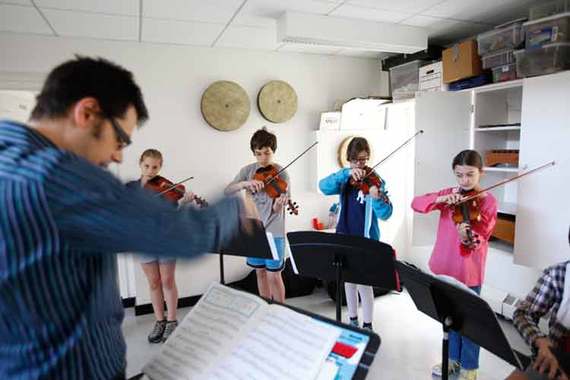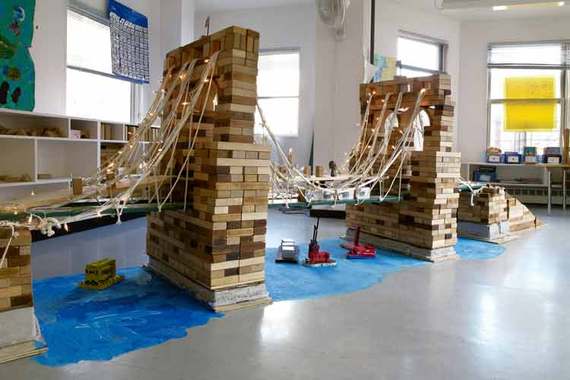The houses are haunted
By white night-gowns.
None are green,
Or purple with green rings,
Or green with yellow rings,
Or yellow with blue rings.
--From "Disillusionment of Ten O'Clock" by Wallace Stevens
When it comes to conformity -- to looking and living alike -- poet and insurance man Wallace Stevens really knew his stuff. These lines are from a poem of his that was published a century ago, in 1915. But there are times when you ask yourself just how much has changed.
With all the pushback these days against standardized testing, and with so much talk about how kids from different backgrounds learn differently, you'd think we'd have a country sprinkled with schools that dedicate themselves to injecting the arts into education. Scratch our surfaces, dig below tattoos and under twists of hair, and you'd hope to find minds full of half-notes, canvases streaked with color, dance moves deep down inside.
Not long ago I took a tour of Trinity Academy for the Performing Arts, an unusual public charter school in Providence, Rhode Island, where I live. Since this is supposed to be an arts-friendly city and state, I was startled that I hadn't heard about TAPA's "arts-integration" approach. Like only a very small number of schools nationally, it takes each of the subjects in its core curriculum (math, English, languages, science, history) and makes them come alive in the classroom through the lens of music, dance, theater, and film.
What I usually hear about -- and read about -- are schools doing the opposite: stripping out programs in music and the arts because of budget cutting, mandated curricula, and testing. "Hmm," I thought, "maybe this is just the moment for TAPA's lively experiment."
When I decided to spend an afternoon at Trinity Academy, I walked into a building that was alive with students absorbed in what they were doing and singing and making. With teachers who were eager for the next class because it would revolve around their own ideas about linking up learning and expression.
Suddenly I was a kid again, back at Manhattan's City & Country School, a pioneer in progressive and arts-focused education that is still going strong, I'm happy to say. At City & Country, where my brother, sister and I spent our elementary school years in the 1960s and early '70s, when we learned about New York City history, we didn't just read about it. We built city block models out of wood and acted in plays about the island's early days. We hung out homemade Dutch and American flags after boiling up enormous vats of plant-based dye.
To this day, each grade level at C&C has a school-wide job, such as running the school post office (8-year-olds) or the school supply store (9-year-olds). Because I was into writing and drawing as a kid, the assignment for 10-year-olds, making school signs, was one of my favorites. I can't forget the cream-colored card-stock we used, or the rubber-stoppled bottles of multicolored India ink. (I like even saying the term "India ink.")
Then there was the foot-pedal-powered iron printing press that was the tool of our year-long trade when we reached 11. Setting type by hand, slotting in "slugs" to make sentences fit, rolling ink onto linoleum blocks for illustrations: all are more indelible to me now than anything I learned (or worked with) in high school or college.
Don't take my word for it. An excellent new book on City & Country has just been published and tells its story better than I can. Through the Passageway, by Jane Llewellyn Smith, is part memoir and part lively history and is infused with stories, photographs and songs from the 30 years Smith spent teaching at C&C.
I know, I know. This kind of education isn't for everyone, and it's the absolute flip-side of trendy. But thinking back to Wallace Stevens' poem -- his "purple with green rings," his "yellow with blue rings." schools like C&C and TAPA are pretty good at cultivating inventiveness, even quirkiness, wherever they can find it.
Inside a visitor on a humdrum afternoon. Inside a kid from some tough neighborhood in town.
Can they, when the chalk dust has settled, unfold a different sort of road map to educational quality? I am confident they can.
Peter Mandel is the author of the read-aloud bestseller Jackhammer Sam (Macmillan/Roaring Brook) and other books for kids, including Zoo Ah-Choooo (Holiday House) and Bun, Onion, Burger (Simon & Schuster).



